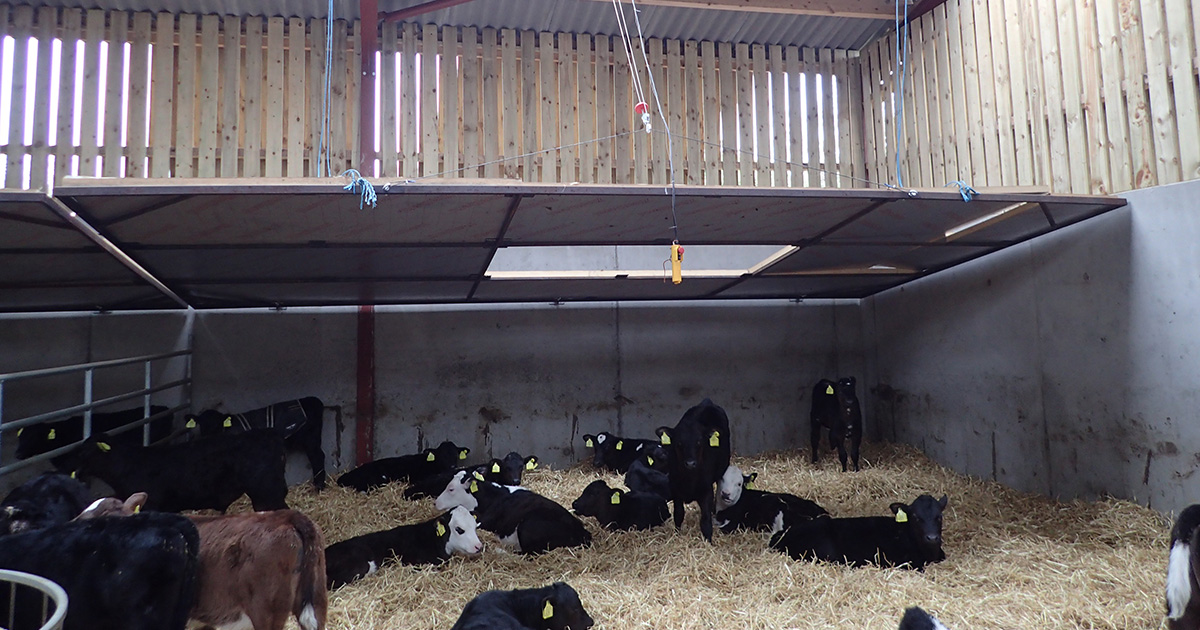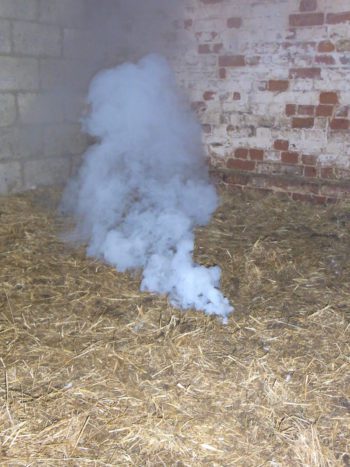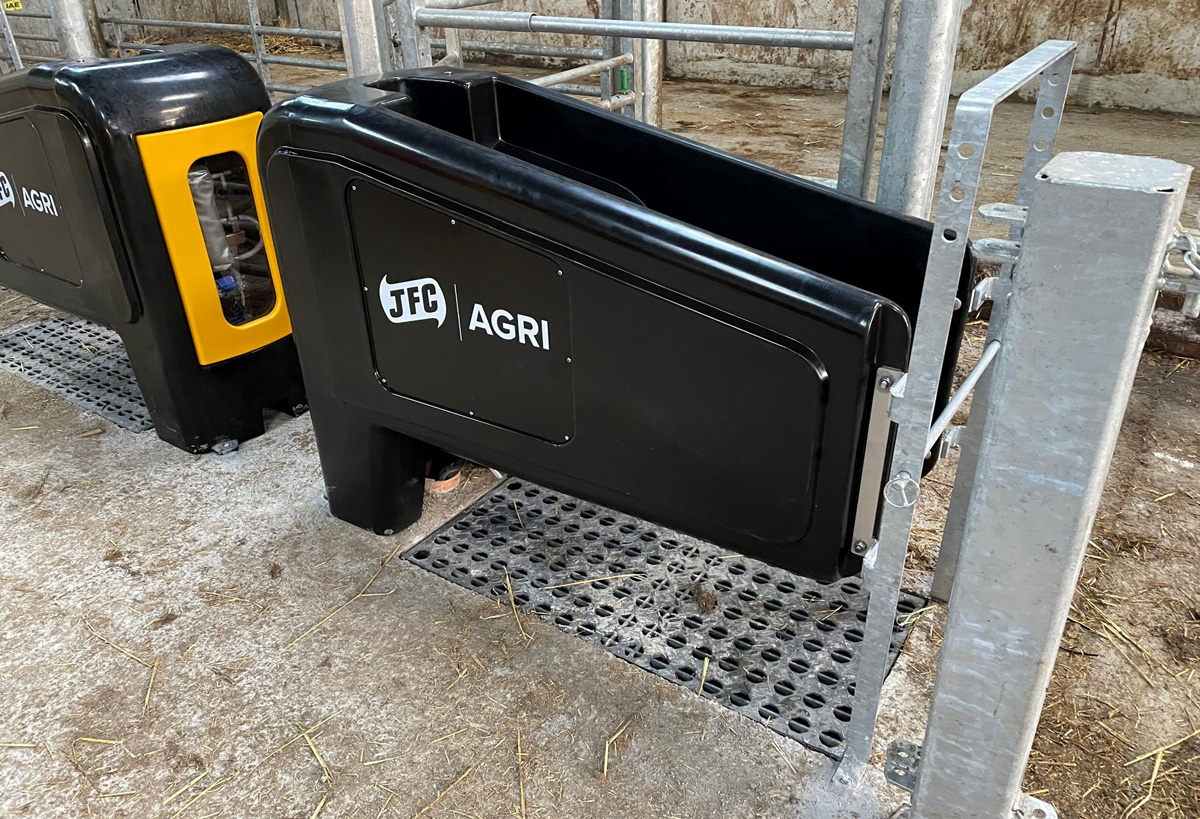3 Oct 2023
Bovine respiratory disease: focus on getting the environment right
Tim Potter outlines five key questions veterinarians can use to assess calf housing and reduce the risk of this condition.

Adjustable shelves at the back of pens can provide additional space.

Bovine respiratory disease (BRD) still remains a significant issue in cattle production systems worldwide, with the impact it has on animal welfare, productivity and economics well documented. It is a multifactorial condition, with numerous viral and bacterial agents being implicated in the disease process.
As veterinary surgeons, our involvement in managing BRD is often focused on the effective identification and treatment of the disease, diagnostic work-ups to identify the underlying pathogen and advice on how to improve immunity through colostrum management and implementation of vaccination programmes.

It is important to remember the environment within which a calf is housed can also have a significant effect on health and welfare parameters (Nordlund and Halbach, 2019) and environmental stressors are major drivers of BRD (Lago et al, 2006).
As vets, we are uniquely positioned to provide trusted advice to our clients on all aspects of BRD control and it is important that this advice includes objective assessment of, and practical recommendations for, the improvement of the environment.
The role of the vet as an advisor on calf housing was acknowledged in the recently announced Calf Housing for Health and Welfare grant, which is providing funding for new calf housing projects and requires a consultation with a vet as part of the application process.
In this article, we will consider the key aspects of calf housing that can impact on BRD and how they should be optimised to reduce the risk of this disease.
It is possible to undertake a reasonable assessment of calf housing with minimal equipment. A laser tape measure enables rapid measurement of a building’s dimensions, a handheld anemometer enables air speed to be measured at different points in the shed and smoke pellets can be used to visually assess the movement of air within a building.
Temperature data loggers can be used to measure the interior temperatures of sheds over time, although getting clients to install more visual environmental thermometers can encourage better engagement with the importance of the environment on calf performance.
When assessing any calf environment, key questions to consider are:
- Is sufficient space available for the stock being housed?
- Is the shed well ventilated with fresh air and is that air well distributed?
- Is the environment draught free?
- Is the environment warm and dry?
- Is the environment currently clean and designed to be cleanable?
Space allowance
Overstocking can lead to problems with respiratory disease, even if the building is well designed and has appropriate ventilation. It is, therefore, important to think about the numbers and size of stock being kept in any building.
Providing sufficient lying and loafing space is key; Table 1 gives a guide to the minimum areas outlined by farm assurance standards and highlights the importance of checking against the compliance standard the farm is operating with.
| Table 2. Minimum space allowances as stipulated by Red Tractor Assurance Scheme (2017) and RSPCA Assured – beef (2023) |
|||||
|---|---|---|---|---|---|
| Red Tractor standards (minimum space allowance m2 per head) | RSPCA Freedom Foods (minimum space allowance m2 per head) | ||||
| Size of stock (kg) | Bedded area | Total area (including bedding, loafing, feeding) | Size of stock (kg) | Bedded area | Total area (including bedding, loafing, feeding) |
| 50-84 | 1.5 | ||||
| 85-140 | 1.8 | < 100 | 1.5 | 3.3 | |
| 140-200 | 2.4 | 101-199 | 2.5 | 5.0 | |
| 200-299 | 2.0 | 3.0 | 200-299 | 3.5 | 6.0 |
| 300-399 | 2.75 | 3.95 | 300-399 | 4.5 | 7.0 |
| 400-499 | 3.5 | 4.9 | 400-499 | 5.5 | 8.0 |
| 500-599 | 4.25 | 5.85 | 500-599 | 6.0 | 8.5 |
| 600-699 | 5.0 | 8.8 | 600-699 | 6.5 | 9.0 |
It is worth noting that the recently announced grant opportunity specifies space allowances of a minimum floor area of 3m2 per calf for calves less than 100kg, 4m2 per calf for calves between 100kg and 150kg, and 5m2 per calf for calves heavier than 150kg.
When assessing space allowance, always think about how the shed will be used at different times of year and make sure sufficient space is available at the busiest times. Remember the impact of calving pattern and the associated animal numbers. For practical purposes, it is always good practice to build in at least 20% contingency to cater for variations in cattle size, extending housing periods and other circumstances; for example, movement restrictions because of challenges such as TB.
Ventilation
In a well-ventilated shed, the air flow will help remove dust, noxious gases, excess moisture and bacteria from a building and, at the same time, provide fresh air into the building without the creation of draughts. Overall, the ventilation rate of a building in air changes per hour should be at least four full air changes in the winter, rising to 60 full air changes in the summer.
Airborne particles such as dust originate from the calves, the bedding or from dry feeds, and can have adverse effects on the health of the calf, irritating the respiratory tract and causing an increased risk of BRD due to pathogen transfer (Urso et al, 2021). Ammonia at levels of 25ppm will irritate the mucous membranes and also make the animal more vulnerable to respiratory diseases. Schnyder et al (2019) found that levels of ammonia more than 10ppm were linked to increased antimicrobial usage in veal calves.
While calibrated meters are available for assessment of air quality, it is also possible to utilise sensory evaluation for ammonia and dust to give a general indicator of the state of the air in a shed.
| Table 2. Scoring system for sensory evaluation of dust and ammonia in livestock housing – from RSPCA Freedom Foods welfare standards for beef cattle (2023) | |
|---|---|
| Score | Description |
| 0 | Zero: odour and dust not noticeable; easy to breathe. |
| 1 | Weak: odour and dust hardly noticeable; can breathe without effort. |
| 2 | Moderate: odour and dust distinct; experience watery eyes and/or coughing. |
| 3 | Strong: odour and dust irritating; experience stinging eyes and/or mouth, and/or excessive coughing/sneezing. |
Air quality can be assessed using the criteria outlined in Table 2, with observations being taken at calf level.
Good stock buildings allow air to flow as a wind-driven effect across a building or to be drawn easily from the eaves up to an open ridge by natural ventilation or the stack effect. The stack effect operates on the principle of thermal buoyancy, that is the difference in weight between two currents of air caused by their difference in temperature.
Air warmed by the stock will rise from stock level to a higher point in the building and be replaced by colder, denser air from outside. For this to operate effectively, the key factors are the difference in height between the inlet and the outlet (sheds with a roof pitch of less than 15° will struggle to ventilate well) and the heat generated by the stock within the building. The amount of heat produced is dependent on the bodyweight, feed intake and resultant metabolic rate of the stock.
Unlike adult cows, calves do not generate sufficient heat to effectively warm the air that surrounds them to allow for thermal buoyancy to occur; therefore, natural ventilation becomes insufficient, necessitating the need for mechanical ventilation in many cases. It is beyond the scope of this article to provide detailed account of the step-by-step calculation to determine the minimum inlet and outlet required for adequate natural ventilation during still conditions. Further information on the calculations can be found in the Farm Buildings Handbook (2019) and in Agriculture and Horticulture Development Board’s Better Cattle Housing Design publication.
As a rough guide, a ridge outlet area of 0.04m2 per animal is required up to 100kg liveweight, with this requirement rising to 0.1m2 for fast-growing and adult stock.
Note these figures are modified by stocking densities and roof pitch. Inlet areas need to be at least twice, but ideally four times the calculated outlet areas.
The aim should be, where possible, to ventilate the building from the sides. Inlet areas in the gable ends are only recommended where the building is excessively wide (more than 25m) or when inlet along one side of the shed is obstructed.
Air inlets can be provided by materials such as space boarding, Yorkshire boarding or vented sheeting – the exact choice will depend on the amount of inlet and the degree of protection required from potential weather ingress.
It is important to design the inlets such that they do not cause draughts at stock level. In existing buildings, it can be possible to make arrangements to avoid this with “shelves” at the back of pens, positioned below the inlets, yet above the stock, which effectively create a sheltered and protected lying area for the stock and that may mitigate the issues caused by a draught problem.
Outlet from most sheds is best provided by a narrow opening along the length of the ridge, 150mm to 350mm wide, dependent on stocking and building design.
The wider the opening is, the more likely rainwater is to come in.
The use of upstands will reduce the amount of water able to ingress and improve exhaust ventilation, and may be sufficient in areas of low rainfall and where the ridge is above non-bedded areas, such as feed passageways or collecting yards.
In areas of high rainfall, or when water ingress is undesirable (for example, directly over bedded areas) a covered ridge should be used. It is worth remembering that, while common place, cranked ridges do not provide sufficient air outlet.
Given the challenges with naturally ventilating calf sheds, we are seeing increasing adoption of positive pressure tube ventilation (PPTV) systems, which can increase the supply of fresh air into buildings. The system draws air from outside the shed and then evenly distributes it along the length of the tube; air then exits passively through the typical ridge opening. If designed properly, the tube system will deliver fresh air without a draught into calves’ micro-environments.
In sheds with PPTV systems fitted, no draught should be coming from the tube at the level of the calves. Producers often query whether an additionally cooling effect exists, meaning they should be shut off during winter. If set up correctly, the cooling effect should be minimal and the benefit of maintaining the minimum number of air changes per hour by keeping the tube on constantly far outweighs this.
The health benefits of PPTV systems have been demonstrated, with Jorgensen et al (2017) identifying that sheds that did not use positive pressure ventilation tubes had 80.6% increased odds of a calf having pyrexia when assessed by calf scoring.
Draughts
When improving the airflow into a shed to improve ventilation, it is important we do not create draughts at calf level that will have a negative impact on calf health and performance, an d create a chilling effect, which can result in the calves being kept at temperatures below their lower critical temperature.
While no exact definition exists of what constitutes a draught, Buczinski et al (2018) identified that air speeds of more than 0.3m/s led to increased heat loss and, therefore, impaired performance.
When considering the risk of BRD, air speeds of more than 0.5m/s are associated with an increased risk of moderate to severe lung sounds on auscultation (Lundborg et al, 2005), and speeds of more than 0.8m/s are associated with increased odds of lung consolidation (van Leenen et al, 2020).
It is possible to measure wind speed at calf level using an anemometer; however, remember that draughts will be very dependent on the prevailing weather conditions and assessing the level of draught in a shed cannot be done on a single visit. Close attention should therefore be paid to the building design. No air inlets should be present, including open doors, below 1.2m from the ground. Doors must be kept closed at all times. Sheds cannot rely on open doorways for ventilation. Look out for gaps under sheeted gates as these cause draughts at calf level. They can be easily fixed by attaching rubber sheeting to the bottom of gates.

Moisture management
Moisture is produced by all livestock in their breath, urine, faeces and sweat, and within any shed this volume of liquid can also be added to by management factors such as feeding and cleaning activities, as well as deficits in the shed such as leaking roofs, drainpipes or water troughs. Excess moisture increases the risk of bacteria and virus survival (Colenutt et al, 2016), increases the risk of dirty water transmitting infection, increases the requirement for bedding and also reduces ambient temperatures.
Control of moisture in calf houses is essential and requires good drainage alongside effective ventilation. The risk of BRD is increased in group housing environments where poor ventilation and drainage persists (Cobb et al, 2014). Good drainage is needed to remove urine and faeces as well as spilled water and milk from the floor.
Ideally, drainage channels should be present at the front of pens and around automatic feeders. Floors in areas of expected high moisture levels should have a minimum slope of 1 in 20.

Ease of cleaning
While not exclusively for the management of BRD, it is important that calf accommodation can be easily cleaned and disinfected to reduce the overall disease challenge.

Effective cleaning means the removal of all organic matter; use of a relevant disinfectant at the right dilution for the required contact time; and washing and drying so it is important that time is made for this periodically throughout the year and only when the shed is empty. Rendering surfaces or fixing stock boarding or similar to harder to clean surfaces can make the cleaning process easier and much more likely to get done properly.
Conclusion
Veterinary surgeons are uniquely positioned to provide a holistic overview of all risk factors and preventive strategies for reducing BRD on farm.
It is important that the impact of the environment is not underplayed and that we engage with our clients on how to optimise cattle housing if we are truly going to see improvements in the control of this disease.
